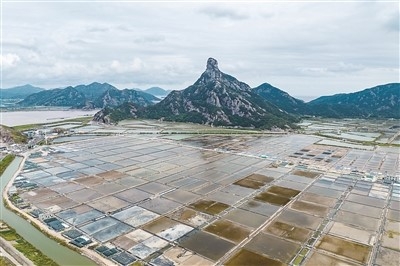Hua’ao Saltworks become a tourist destination
- Details
- Category: Ningbo District
- Published: Monday, 24 October 2022 14:38

As is reported, in the first several days of the National Day holiday, Gaotang Island Township in Xiangshan County witnessed a daily average of over 3,000 tourists, and many of the family tourists went to the Hua’ao Saltworks for a visit. As the last manual sea salt
drying saltworks in Zhejiang Province, Hua’ao Saltworks is the last witness to the history of development saltworks in the county.
There are records of salt production in Xiangshan County in the “New Book of Tang Dynasty”. For over a thousand years, the salt drying area has been distributed in the marginal sea area of the county, starting from Qiancang in the north, turning from Juexi River to Shipu Town and Sidu Village in the south, and stretching for over 200 li. Historically, it is known as a large salt producing area.
Approved by the former Light Industry Department of Zhejiang Province in March 1968, the saltworks was completed and put into operation in 1971. At that time, there were 34 salt fields, with the total area of over 1,700 mu.
However, with the eclipse of time, many saltworks in Xiangshan have been closed or transformed. Hua’ao Saltworks has become the only salt farm still in operation, but its production area has been reduced to 1200 mu. In order to protect this cultural heritage, the staff of Xiangshan County Cultural Center began to investigate, collect and sort out relevant information in 2015. Finally, the salt drying technique of the county was successfully included in the second national intangible cultural heritage list in 2008.
Since then, more efforts have been made by departments concerned to protect and reserve the key salt fields. The salt field protection areas have been included in the coastal tourism planning, the inheritors of intangible cultural heritage have been protected, and the systematic research on Xiangshan salt drying and salt culture has been carried out. By taking advantage of the protection effort, Hua’ao Saltworks has ushered in a major turning point in history in 2016. The local government and the board of directors of the saltworks negotiated with Ningbo Xinfengtai Salt Industry Development Co., Ltd. and decided to entrust it to contract the first phase for 15 years. So far, the company has invested over 30 million yuan to comprehensively upgrade the infrastructure and production equipment of the salt field, with the goal of building a production base with an annual output of 8,000 tons of high-quality sea salt.
In early 2017, Hua’ao Saltworks was identified as the inheritance base for sea salt drying technique, a national intangible cultural heritage item. Subsequently, the departments concerned have invested 600,000 yuan to build the Hua’ao Saltworks Museum, which integrates such functions as exhibition, research and tourism.
The saltworks has gradually become more a tourist destination than a “factory”. According to Hu Hui, the head of the saltworks, Hua’ao Island, known as the “marine stone forest”, is a geological park in Zhejiang Province. How to integrate the beauty of the salt farm and the island to strengthen tourism has long been the goal they have been working hard on.
To break the development bottleneck, Hu Hui and his team have made great efforts to the integrated development of educational excursions and the rural tourism. During this year’s summer vacation and the National Day holiday, the saltworks received over 10,000 visits, making it an “Internet-famous tourist destination”








